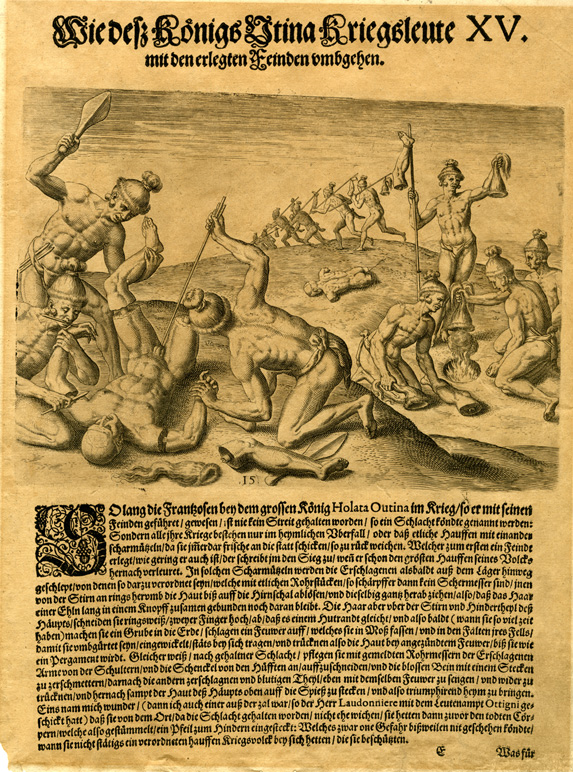Florida Memory is administered by the Florida Department of State, Division of Library and Information Services, Bureau of Archives and Records Management. The digitized records on Florida Memory come from the collections of the State Archives of Florida and the special collections of the State Library of Florida.

State Archives of Florida
- ArchivesFlorida.com
- State Archives Online Catalog
- ArchivesFlorida.com
- ArchivesFlorida.com
State Library of Florida
Related Sites

Description of previous item
Description of next item

Plate XV.
How Outina's Men Treated the Slain of the Enemy
During all the time that the French had dealings with the great chief Olata Outina in the war against his enemies, no pitched battle was fought. It all happened in ambushes and skirmishes, fresh troops constantly replacing those who retired. Whoever put the enemy to flight first was credited with victory, even when the number of his losses was very large. In these skirmishes those who fall are immediately dragged off by men especially charged with this duty. With a sliver of reed, sharper than any steel blade, they cut the skin with the hair from the skull all the way round, the longest hairs being twisted into a plait, the hair from the forehead being rolled up for the length of two fingers with that of the back of the head in the manner of the ribbon of a bonnet. Immediately afterwards (if they have time), they dig a hole where they make a fire of smouldering moss which they carry around in their leather breechclouts. The fire lit, they dry the scalp until it becomes hard like parchment. At the end of the battle, they are accustomed to cut the arms of their victims off at the shoulder and their legs at the thighs. The bones laid bare are crushed and the pieces, still dripping with blood, are dried on the same fire. Then they return home triumphantly with the skin of the heads at the ends of their spears. What astonished me (for I was one of the men sent by Laudonnière under Ottigny's command), was that they never left the place of battle without piercing the mutilate corpses of their enemies right through the anus with an arrow. During this task a protective force always surrounded them.
The digital copies of the de Bry engravings (N2012-6) included here are made possible by a donation from the Michael W. and Dr. Linda Fisher Collection.
All translations are taken from Discovering the New World, Based on the Works of Theodore de Bry, edited by Michael Alexander (New York: Harper & Row, 1976).
Title
Subject
Description
Creator
Source
Date
Contributor
Format
Language
Type
Identifier
Coverage
Thumbnail
Transcript
Plate XV.
How Outina's Men Treated the Slain of the Enemy
During all the time that the French had dealings with the great chief Olata Outina in the war against his enemies, no pitched battle was fought. It all happened in ambushes and skirmishes, fresh troops constantly replacing those who retired. Whoever put the enemy to flight first was credited with victory, even when the number of his losses was very large. In these skirmishes those who fall are immediately dragged off by men especially charged with this duty. With a sliver of reed, sharper than any steel blade, they cut the skin with the hair from the skull all the way round, the longest hairs being twisted into a plait, the hair from the forehead being rolled up for the length of two fingers with that of the back of the head in the manner of the ribbon of a bonnet. Immediately afterwards (if they have time), they dig a hole where they make a fire of smouldering moss which they carry around in their leather breechclouts. The fire lit, they dry the scalp until it becomes hard like parchment. At the end of the battle, they are accustomed to cut the arms of their victims off at the shoulder and their legs at the thighs. The bones laid bare are crushed and the pieces, still dripping with blood, are dried on the same fire. Then they return home triumphantly with the skin of the heads at the ends of their spears. What astonished me (for I was one of the men sent by Laudonnière under Ottigny's command), was that they never left the place of battle without piercing the mutilate corpses of their enemies right through the anus with an arrow. During this task a protective force always surrounded them.
Chicago Manual of Style
Bry, Theodor de, 1528-1598. XV. How Outina's Men Treated the Slain of the Enemy. 1591. State Archives of Florida, Florida Memory. <https://www.floridamemory.com/items/show/294781>, accessed 18 December 2025.
MLA
Bry, Theodor de, 1528-1598. XV. How Outina's Men Treated the Slain of the Enemy. 1591. State Archives of Florida, Florida Memory. Accessed 18 Dec. 2025.<https://www.floridamemory.com/items/show/294781>
AP Style Photo Citation

 Listen: The Latin Program
Listen: The Latin Program